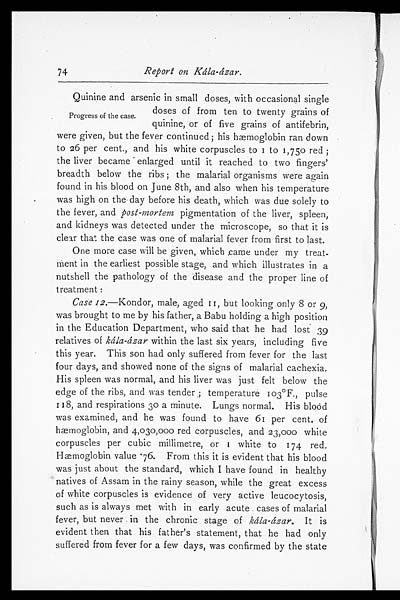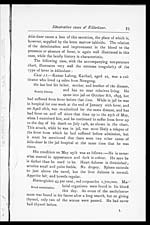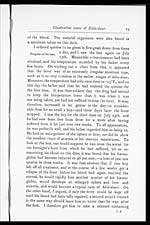Medicine - Institutions > Army health reports and medical documents > Report of an investigation of the epidemic of malarial fever in Assam, or, kala-azar > Section III - Clinical description of kala-azar
(99) Page 74
Download files
Individual page:
Thumbnail gallery: Grid view | List view

74
Report on Kála-ázar
Progress of the case.
Quinine and arsenic in small doses, with occasional single
doses of from ten to twenty grains of
quinine, or of five grains of antifebrin,
were given, but the fever continued; his hæmoglobin ran down
to 26 per cent., and his white corpuscles to 1 to 1,750 red;
the liver became enlarged until it reached to two fingers'
breadth below the ribs; the malarial organisms were again
found in his blood on June 8th, and also when his temperature
was high on the day before his death, which was due solely to
the fever, and post-mortem pigmentation of the liver, spleen,
and kidneys was detected under the microscope, so that it is
clear that the case was one of malarial fever from first to last.
One more case will be given, which came under my treat-
ment in the earliest possible stage, and which illustrates in a
nutshell the pathology of the disease and the proper line of
treatment:
Case 12 .—Kondor, male, aged 11, but looking only 8 or 9,
was brought to me by his father, a Babu holding a high position
in the Education Department, who said that he had lost 39
relatives of kála-ázar within the last six years, including five
this year. This son had only suffered from fever for the last
four days, and showed none of the signs of malarial cachexia.
His spleen was normal, and his liver was just felt below the
edge of the ribs, and was tender; temperature 103°F., pulse
118, and respirations 30 a minute. Lungs normal. His blood
was examined, and he was found to have 61 per cent. of
hæmoglobin, and 4,030,000 red corpuscles, and 23,000 white
corpuscles per cubic millimetre, or 1 white to 174 red.
Hæmoglobin value 76. From this it is evident that his blood
was just about the standard, which I have found in healthy
natives of Assam in the rainy season, while the great excess
of white corpuscles is evidence of very active leucocytosis,
such as is always met with in early acute cases of malarial
fever, but never in the chronic stage of kála-ázar. It is
evident then that his father's statement, that he had only
suffered from fever for a few days, was confirmed by the state
Set display mode to: Large image | Zoom image | Transcription
Images and transcriptions on this page, including medium image downloads, may be used under the Creative Commons Attribution 4.0 International Licence unless otherwise stated. ![]()
| Permanent URL | https://digital.nls.uk/75014543 |
|---|




